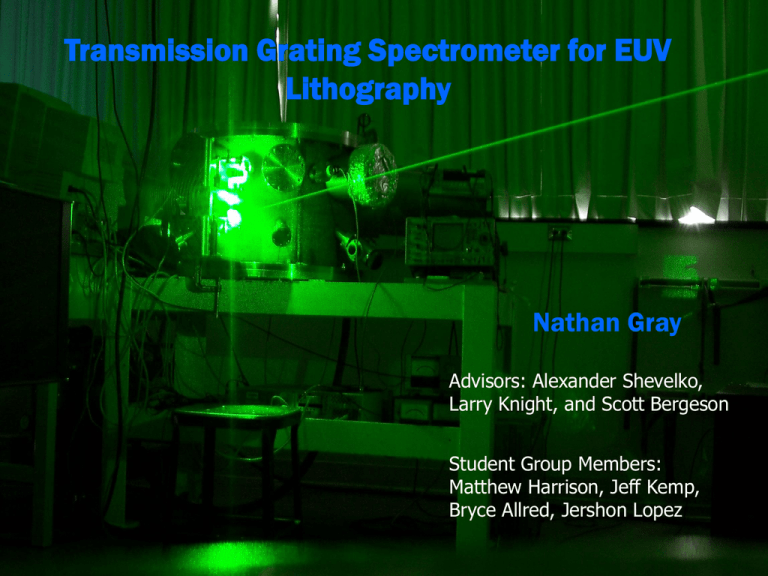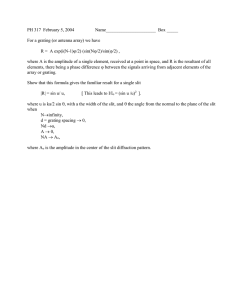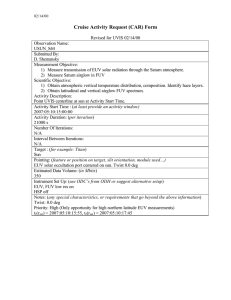Transmission Grating Spectrometer for EUV Lithography Nathan Gray
advertisement

Transmission Grating Spectrometer for EUV Lithography Nathan Gray Advisors: Alexander Shevelko, Larry Knight, and Scott Bergeson Student Group Members: Matthew Harrison, Jeff Kemp, Bryce Allred, Jershon Lopez Extreme Ultraviolet (EUV) 1-1000 Å Image modified from: NASAexplores Models of the Electromagnetic Spectrum student sheet. lot.astro.utoronto.ca/spectrum.html Extreme Ultraviolet (EUV) 1-1000 Å Absorbed by Everything: •Air Image modified from: NASAexplores Models of the Electromagnetic Spectrum student sheet. lot.astro.utoronto.ca/spectrum.html Extreme Ultraviolet (EUV) 1-1000 Å Absorbed by Everything: •Air •Glass Image modified from: NASAexplores Models of the Electromagnetic Spectrum student sheet. lot.astro.utoronto.ca/spectrum.html Extreme Ultraviolet (EUV) 1-1000 Å Absorbed by Everything: •Air •Glass •Plastic Image modified from: NASAexplores Models of the Electromagnetic Spectrum student sheet. lot.astro.utoronto.ca/spectrum.html Extreme Ultraviolet (EUV) 1-1000 Å Absorbed by Everything: •Air •Glass •Plastic •Ponies Image modified from: NASAexplores Models of the Electromagnetic Spectrum student sheet. lot.astro.utoronto.ca/spectrum.html Extreme Ultraviolet (EUV) Must operate under vacuum (our chamber is at 30-100 mtorr) Absorbed by Everything: •Air •Glass •Plastic Must use mirrors in place of conventional optics. This makes spectroscopy in the EUV range complicated. EUV range transmission gratings: EUV range transmission gratings: Recent transmission grating development allows for EUV range gratings 200 nm period (5000 lines/mm) EUV range transmission gratings: Recent transmission grating development allows for EUV range gratings 200 nm period (5000 lines/mm) Transmission grating spectrometers are superior to reflection grating spectrometers Possible Configurations Simple Transmission Grating Spectrometer Entrance Slit Detector Grating Possible Configurations Single Mirror Geometry Spherical Mirror Entrance Slit Detector •High spectral resolution and luminosity •Mirror collects large solid angle Grating Our Configurations Double Mirror Geometry Detector Entrance Slit Flat Mirror Spherical Mirror Designed by Dr. Alexander Shevelko Grating Knight/Shevelko Group Spectrometer Configuration Intensity (counts) 4000 3000 5000 0 2000 50 1000 100 Wavelength (Ǻ) 6000 OVI 2s-3p 150.1Ǻ OVI 2p-4d 129.8Ǻ OVI 2s-4p 115.83Ǻ, 2p-5d 115.83Ǻ 2 BIV 1s -1s2p 60.3Ǻ 2 2 BIV 1s -1s3p 52.7Ǻ, 1s -1s4p 50.4 Ǻ BV 1s-2p 48.6Ǻ B 7000 #002 EL=405 mJ 40 shot sum 150 OVI 2p-3d 173Ǻ 8000 Grating 5000 ℓ/mm Entrance Slit 250 μm 0 200 FeXVI 3d-4f, FeXVII 3d-4p Fe 20000 FeXV 3d-4f #006 FeXIV 3p-4d FeXVII 3d-4f EL=300 mJ 40 shot sum Intensity (counts) 15000 Grating 5000 ℓ/mm Entrance Slit 250 μm FeXV 3p-4d FeXVI 3p-4d 10000 FeXVI 3s-4p 5000 FeXVI 3d-5f FeXVII 3s-4p FeX-FeXIII 0 0 50 100 Wavelength (Ǻ) 150 200 Electron Temperature Study Tungsten 4000 4000 WXXVIII-WXXX 4-4 transitions 48-65 Ǻ W #015 Grating 5000 ℓ/mm Entrance Slit 250 μm 3000 3000 2500 2500 440mJ 300mJ 200mJ 150mJ 2000 Intensity (counts) Intensity (counts) W 3500 #024 2000 1500 1500 1000 1000 500 500 EL=440 mJ 1 shot WXXII-WXXIX 4-5 transitions 25-38 Ǻ 3500 Grating 5000 ℓ/mm Entrance Slit 250 μm 0 0 0 50 100 150 Wavelength (Ǻ) 200 250 300 0 50 100 150 Wavelength (Ǻ) 200 250 300 Efficiency Calculation Major advantage of transmission grating over reflection grating Must take transmission through wires into account (phase shift) Materials: Au 25 nm Au 25 nm Radiation Si4N3 200 nm Formulae Efficiency Calculation total efficiency Efficiency Total Grating Efficiency 0.006 0.006 0.005 0.005 0.004 0.004 0.003 0.003 0.002 0.002 0.001 0.001 0 0 5 10 15 20 25 30 35 wavelength (nm) Schopper et al. Method 40 45 0 0 5 10 15 20 25 30 Fujikawa et al. Method H. W. Schopper et al., Appl. Opt. 16, 1088 (1977). C. Fujikawa et al., Rev. Sci. Instrum. 69, 2849 (1998). 35 40 45 Absolute Calibration grating efficiency X spherical mirror reflectivity X flat mirror reflectivity = total spectrometer efficiency Absolute Calibration grating efficiency X spherical mirror reflectivity X flat mirror reflectivity = total spectrometer efficiency total spectrometer efficiency X detector calibration = absolute calibration Absolute Calibration grating efficiency X spherical mirror reflectivity X flat mirror reflectivity = total spectrometer efficiency total spectrometer efficiency X detector calibration = absolute calibration absolute calibration = Intensity scaled to units of actual photon flux, instead of just relative intensity. Absolute Calibration grating efficiency X spherical mirror reflectivity X flat mirror reflectivity = total spectrometer efficiency total spectrometer efficiency X detector calibration = absolute calibration absolute calibration = Intensity scaled to units of actual photon flux, instead of just relative intensity. Detector calibration: completed at Lebedev Physical Institute by Oleg Yakushev EUV Lithography International Technology Roadmap for Semiconductors printable patterns with 32 nm between features are required by the semiconductor industry by 2009 EUV Lithography Main limitation is wavelength of light source Higher Resolution requires a source with smaller wavelength Typical EUV wafer scanner V. Bakshi, EUV Sources for Lithography, SPIE Press Book, 2006. EUV Lithography Typical EUV Lithography apparatus: 11 mirror multilayer Mo/Sn multilayer mirrors with reflections around 66% each. The overall transmission in the EUV scanner is less than 1%, The mirrors reflect a bandwidth of 2% around a central wavelength of 135 °A. EUV Lithography Source candidates: Lithium and Tin plasmas 1200 350 Sn (4d-4f) UTA Li III 1s-2p Sn Li 300 EL=450 mJ 100 shot avg EL=425 mJ 1 shot 250 150 Intensity (counts) Li III 1s-3p 200 Grating 5000 ℓ/mm Entrance Slit 250 μm 800 Grating 5000 ℓ/mm Entrance Slit 250 μm Li III 1s-4p, 5p Intensity (counts) #025 1000 #001 600 400 100 50 200 0 75 85 95 105 115 125 Wavelength (Ǻ) 135 145 155 165 175 0 0 50 100 150 Wavelength (Ǻ) 200 250 300 EUV Lithography Mirror heating Unwanted radiation Target purity Plasma parameters (electron temperatures, absolute outputs, etc.) Current WRS Planned WRS with multiple gratings Acknowledgements Dr. Shevelko Dr. Knight Matt Harrison and the other members of my group The chemists (especially Dr. Asplund)


